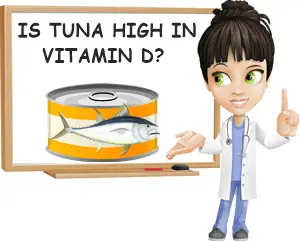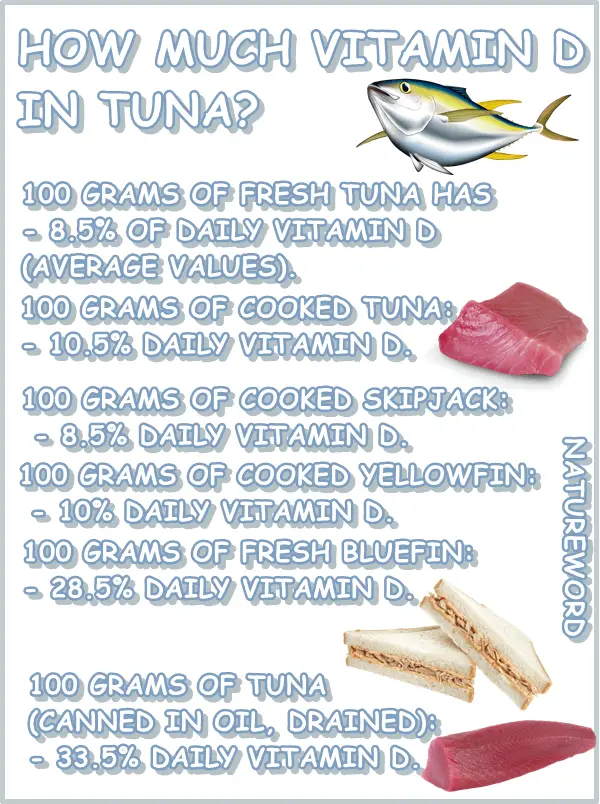Did you know that tuna is a good source of vitamin D? If you are looking to eat more foods high in vitamin D, then know that tuna, and fish in general, are great options to get all or most of your daily vitamin D from. Of course, tuna vitamin D content varies according to the type of tuna, how it’s prepared and how much of it you eat. Nonetheless, tuna remains a good, if not great option to increase your vitamin D levels if they are low, and provides a range of other benefits for health.
How much vitamin D per day?
The average adult with an estimated daily calorie intake of 2000 kcal (kilocalories) needs 20 mcg (micrograms) or 800 IU (International Units) of vitamin D per day, every day, according to the new dietary guidelines for essential vitamins, minerals and other dietary nutrients. The recommended daily intake (RDI) of vitamin D has been raised from 10 mcg (400 IU) a day to 20 mcg (or 800 IU), a significant increase.

Of course, the recommended daily dose of vitamin D varies by country, region, latitude, and from person to person depending on individual nutritional requirements based on age, gender and health specifics, but also occupation. So while the average minimum recommended daily dose of vitamin D for an adult is 20 micrograms, dosage may also be set lower, at 15 mcg of vitamin D daily, or higher, at 25 mcg or more daily dose.
What foods are highest in vitamin D?
Unlike many other essential vitamins and minerals, vitamin D is not present in most foods. In fact, except for mushrooms, some lichen and algae, only animal foods have vitamin D naturally.
Plant foods typically contain vitamin D only if fortified (e.g. flour, breakfast cereals, non-dairy milk, non-dairy cheese, soy byproducts, energy bars and protein bars, sports drinks etc.). Of all animal foods that are naturally sources of vitamin D, only a few are actually high in vitamin D.
Fish are one of the best vitamin D foods you can eat. Depending on species and serving size, the content of vitamin D in fish can range from modest to high. Just as important, fish are readily available foods that most people can afford to eat on a regular basis to help them get good amounts of their daily vitamin D requirements and prevent a deficiency

How much vitamin D does tuna contain?
Tuna is classified as an oily fish, that is, a type of fish with a higher content of fat (as opposed to lighter whitefish). As an oily fish, tuna accumulates vitamin D in its fat tissues and liver naturally – vitamin D is a type of fat soluble vitamins.
Tuna contains a form of vitamin D called simply vitamin D3, or cholecalciferol. This is the same type of vitamin D produced in the skin as a result of sun exposure, and found some of the best vitamin D supplement formulations. Vitamin D3 from tuna is processed in succession by the liver and kidneys, and turned into calcifediol, then calcitriol, the latter being the active form of vitamin D the body uses.
Is tuna high in vitamin D?
Is tuna high in vitamin D? The content of vitamin D in tuna ranges from modest to high, depending on the species of tuna, how it’s processed, and how much of it you eat (serving size). But, generally, tuna is a good source of the essential nutrient, and one of the best foods you can eat to increase your vitamin D levels if they are too low and putting you at risk for a deficiency and associated side effects.
Vitamin D On Tuna, fresh, raw
There are 1.7 mcg of vitamin D per 100 grams of raw, fresh tuna which is 8.5% of daily vitamin D requirements for the average adult. A serving of 85 grams or 3 oz provides 1.44 mcg of vitamin D or 7.2% of total daily vitamin D values.
Vitamin D On Skipjack tuna, fresh, raw
There are 1.7 mcg of vitamin D per 100 grams of raw, fresh skipjack tuna which is 8.5% of the daily dose of vitamin D for the average adult. A serving of 85 grams or 3 oz of skipjack tuna provides 1.44 mcg of vitamin D or 7.2% of total daily vitamin D values.
Vitamin D On Skipjack tuna, fresh, cooked (dry heat)
There are 1.7 mcg of vitamin D per 100 grams of cooked skipjack tuna (dry heat) which is 8.5% of the daily dose of vitamin D for the average adult. A serving of 85 grams or 3 oz of cooked skipjack tuna provides 1.44 mcg of vitamin D or 7.2% of total daily vitamin D values.
Vitamin D On Yellowfin tuna, fresh, raw
There are 1.7 mcg of vitamin D per 100 grams of raw, fresh yellowfin tuna which is 8.5% of the daily dose of vitamin D for the average adult. A serving of 85 grams or 3 oz of fresh yellowfin tuna provides 1.44 mcg of vitamin D or 7.2% of total daily vitamin D values.
Vitamin D On Yellowfin tuna, fresh, cooked (dry heat)
There are 2 mcg of vitamin D per 100 grams of cooked yellowfin tuna (dry heat) which is 10% of the daily dose of vitamin D for the average adult. A serving of 85 grams or 3 oz of fresh yellowfin tuna provides 1.7 mcg of vitamin D or 8.5% of total daily vitamin D values.
Vitamin D On Bluefin tuna, fresh, raw
There are 5.7 mcg of vitamin D per 100 grams of raw, fresh bluefin tuna which is 28.5% of the daily dose of vitamin D for the average adult. A serving of 85 grams or 3 oz of fresh bluefin tuna provides 4.84 mcg of vitamin D or 22.4% of total daily vitamin D values.
Vitamin D On Tuna, fresh, steamed/poached
There are 2.1 mcg of vitamin D per 100 grams of steamed or poached fresh tuna fish which is 10.5% of the daily dose of vitamin D for the average adult. A serving of 85 grams or 3 oz provides 1.785 mcg of vitamin D or 8.9% of total daily vitamin D. One small cooked tuna fillet at an estimated weight of 170 grams has 3.57 mcg of vitamin D or 17.8% of daily vitamin D.
Vitamin D On Tuna, fresh, baked/broiled
There are 2.1 mcg of vitamin D per 100 grams of baked or broiled fresh tuna fish which is 10.5% of the daily dose of vitamin D for the average adult. A serving of 85 grams or 3 oz provides 1.785 mcg of vitamin D or 8.9% of total daily vitamin D. One medium cooked tuna fillet at an estimated weight of 227 grams has 4.77 mcg of vitamin D or 23.85% of daily vitamin D for an adult.
Vitamin D On Tuna, fresh, dried
There are 5.3 mcg of vitamin D per 100 grams of dried tuna, from fresh, which is 26.5% of the daily dose of vitamin D for the average adult.
Vitamin D On Tuna, fresh, smoked
There are 11.3 mcg of vitamin D per 100 grams of smoked tuna, from fresh, which is 56.5% of the daily dose of vitamin D for the average adult. A serving of 85 grams or 3 oz provides 9.6 mcg of vitamin D or 48% of the daily dose of vitamin D for an adult.
Vitamin D On Tuna, canned in oil
There are 6.7 mcg of vitamin D in 100 grams of tuna, canned in oil, drained solids, the equivalent of 33.5% of daily vitamin D requirements for an adult. A serving of 85 grams or 3 oz of tuna, canned in oil, provides 5.7 mcg of vitamin D, the equivalent of 28.5% of the recommended daily dose of vitamin D for an adult. A serving of 1 cup (146 grams) of tuna, canned in oil, drained solids, provides 9.78 mcg of vitamin D or 48.9% of the daily dose of vitamin D for an adult.
Vitamin D On Tuna, canned in water
There are 1.2 mcg of vitamin D in 100 grams of tuna, canned in water, drained solids, which is 6% of daily vitamin D requirements for an adult. A serving of 85 grams or 3 oz of tuna, canned in water, provides 1.02 mcg of vitamin D or 5.1% of the recommended daily dose of vitamin D for an adult. A serving of 1 cup (154 grams) of tuna, canned in water, drained solids, provides 1.85 mcg of vitamin D or 9.25% of the daily dose of vitamin D for an adult.
Vitamin D On White tuna, canned, drained solids
There are 2 mcg of vitamin D in 100 grams of white tuna, canned, drained solids, which is 10% of daily vitamin D requirements for an adult. A serving of 85 grams or 3 oz of white tuna, canned, provides 1.7 mcg of vitamin D or 8.5% of the recommended daily dose of vitamin D for an adult. A serving of 1 cup (172 grams) of white tuna, canned, provides 3.44 mcg of vitamin D or 17.2% of the daily dose of vitamin D for an adult.
How much tuna do you have to eat to get your daily vitamin D?
- To get all of your daily vitamin D dose from just tuna, you would have to eat, on average, 1.176 kg of fresh tuna in a day. You can eat it raw, in sushi or sashimi, or cooked, as tuna steak.
- To get all of your daily vitamin D dose from cooked tuna, you would have to eat approximately 952 grams of cooked tuna per day – boiled, steamed, poached, baked or broiled, from fresh.
- To get all of your daily vitamin D dose from smoked tuna, you would have to eat about 177 grams in a day.
- To get all of your daily vitamin D dose from canned tuna (oil pack), you would have to eat close to 300 grams of tuna canned in oil, drained, in a day.
